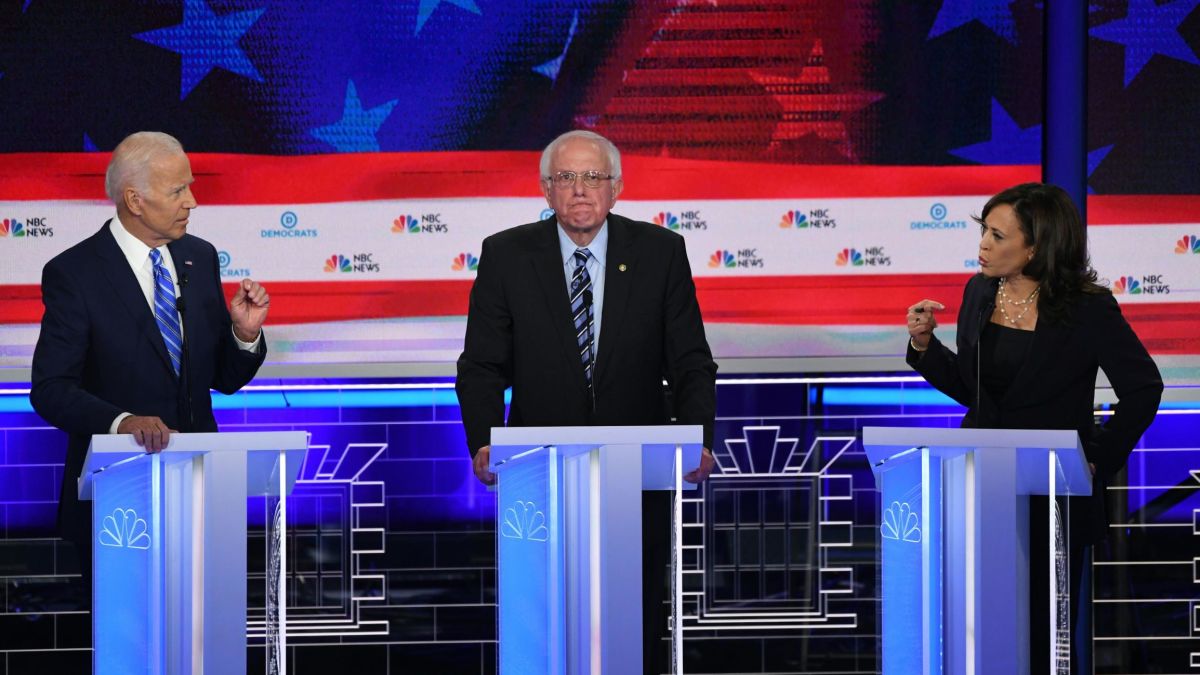Hello Everyone:
It is a sparkling summer Monday to start a short week on the Blog. Blogger Candidate Forum is off for the Fourth of July holiday but it will make its presence known, like today.
 |
| VPOTUS Joe Biden, Senators Kamala Harris and Bernie Sanders cnn.com |
Yours Truly randomly chose the picture on the left but upon further reflection, the image of Senator Kamala (D-CA) involved in an exchange with VPOTUS Joe Biden (D-DE) with Senator Bernie Sanders (D-VT) looking very frustrated speaks volumes about last Thursday's debates. In case you missed it during the debate, Senator Harris eloquently shared her experience of being a black child and bused to a school, away from a school in her Oakland, California which put VPOTUS on the defensive, leaving Senator Sanders stuck in the middle without a say. The point of her story to was to call VPOTUS out on his fond remembrances of working with two senators who built their careers on maintaining segregation and his vote on school desegregation. It was a moment that rocketed Senator to national prominence. Yours Truly wants to take look at school desegregation and its impact in Los Angeles.
 |
| Forced busing protest at Hamilton High School (1980) Los Angeles, California kcet.org |
Mandatory school desegregation (i.e. forced busing) began innocently in 1961 when Mary Ellen Crawford, an African American teen, tried to enroll at her neighborhood high school, South Gate High School. The Los Angeles Unified School District turned down her request, directing her to enroll at the more distant Jordan High School, with a student body that was 99 percent African American, compared to SGHS' 98 percent Caucasian student body (library.csun.edu; Feb. 26, 2013, date accessed July 1, 2019). Her parents filed suit in Superior Court, alleging discriminatory attendance boundary practices (Ibid).
 |
| Leapwood Elementary School, 1970 time.com |
By August 1963, the American Civil Liberties Union, acting on behalf of the Crawford family and a group of minority students, filed a class action suit against the LAUSD, hoping to segregate two schools. After five years of fruitless negotiations, the ACLU, together with the NAACP, expanded their goal to desegregating all the school within the LAUSD. In 1970, Judge Alfred Gitelson ruled that the Los Angeles Board of Education and the LAUSD engage in de jure segregation, violating the state and federal Constitutions, and ordered the board to prepare a plan for desegregating the district (Ibid). After several attempts, the school board devised a plan to be implemented in 1978, called for mandatory student reassignment and busing. The plan was never carried out because it was challenged in court by BUSTOP, Inc. a grassroots organization opposed to desegregation (Ibid).
In 1979, the California State Legislature placed a constitutional amendment, Proposition 1, on the ballot. Prop 1 (i.e. Robbin's Amendment) "declared that school boards had no obligation or responsibility to exceed the guarantees of the Equal Protection Clause of the Fourteenth Amendment with regard to student school assignment or pupil transportation" (Ibid). Prop 1 passed by more than two-thirds, ending all mandatory desegregation and busing, even though students were (and still are) able to go to their local school (Ibid). In its place, Los Angeles shifted to a voluntary busing program under court supervision (latimes.com; June 27, 2019). This evolved into the "magnet" programs. The goal of the "magnet" program, attractive to white schools, in schools that the white students would not otherwise attend (Ibid). This is a very brief summary of an incredibly complicated history.
Another element of the program essentially allowed minority students from low- and moderate income neighborhoods in South Los Angeles to take buses to schools in more affluent communities in the San Fernando Valley. This gave some Valley schools a much needed enrollment burst to fill out the classrooms. The daily commute, Permits With Transportation (Ibid; June 29, 2019), did not happen in reverse. The impact of mandatory desegregation is still felt today.
| Parent with children boarding buses laprogressive.com |
Mandatory desegregation and busing (latimes.com; Sept. 28, 1997; date accessed July 1, 2019) was on of the most polarizing issues of 1970s Los Angeles. It led to protests, political movements (library.csun.edu; Feb. 26, 2013), and "white flight"--white families exiting the Los Angeles Unified School District. The issue was resurrected during last Thursday's debate during an exchange between Senator Harris and VPOTUS. During the passionate exchange, Senator Harris took VPOTUS to task for not taking the "morally correct position" (latimes.com; June 27, 2019) in favor of a more aggressive federal role in order to achieve school integration.
Desegregating the California schools was part of a broader integration effort which included the elimination of "redlining," which kept African American and other minority groups from buying homes in "white" communities. Redlining was in force in Los Angeles and elsewhere, making mandatory busing a possible remedy for the effects of segregation. The idea was "schools for all students improve if white students had to share the fate of black students" (Ibid; June 29, 2019). That is not what actually happened.
| The first African American students to attend Plymouth Elementary School Monrovia, California Sept. 10, 1970 latimes.com |
In the late seventies, over two decades after the United States Supreme Court outlawed segregated schools in Brown v. Board of Education, the Los Angeles Unified School District prepared for mandatory busing after failed attempts to prevent it.
The efforts to block mandatory busing was spurred by the majority white middle class and permeated local and state politics as the buses were barely getting underway. The white families deliberately moved to suburban districts that were more homogeneous, with no busing or simply enrolled their child(ren) in private schools. Los Angeles School Board President Howard Miller was recalled by local voters. Mr. Miller was not supportive of mandatory desegregation but pledged to enforce the law which was enough to doom his political aspirations. In his place, busing opponents Bobbi Fiedler and Roberta Weintraub were elected to the school board.
 |
| Two students at Bravo Medical Magnet High School Los Angeles, California laschoolreport.com |
The magnet programs have had measurable success in schools like Bravo Medical Magnet School but the integration benefits were limited.
The landmark Brown v. Board of Education (1954) became more than a sliver of opening up of opportunity. According to a report from the UCLA Civil Rights Projects, in the over the sixty years since its Brown, the effect has been gradual (civilrightsprojects.ucla.edu; May 10, 2019; date accessed July 1, 2019). The reported observed,
The passage of the 1964 Civil Rights Act as well as a series of Supreme Court decisions in the 1960s and early 1970s produced momentum towards increased desegregation for block students that lasted until the late 1980s, as districts across much of the country worked to achieve the promise of Brown--integrated schools for all children... (latimes.com; June 29, 2019).
Segregation is no unique to the Southern United States. New York is still the most segregated state for African Americans students: "65% of black students in 'intensely segregated' schools, according to the Civil Rights Projects. California is the most segregated for Latinos, where 58% attend intensely segregated school, and the typical Latino student is a in a school with only 15% white classmates" (Ibid). Recently, the conservative leaning Supreme Court has rolled back the imperative to desegregate. For example, in 2007, SCOTUS ruled that race could not be a factor in school enrollment at public institutions. Berkeley Unified, where Senator Kamala Harris went to school, experimented with economic data from census tracts. The idea was to substitute poverty for race, because poverty is closely associated with race (Ibid).
 |
| Hamilton Academy of Music and Performing Arts Los Angeles, California hamiltonmusic.org |
The affects of mandatory desegregation and busing continue to be felt not only in Los Angeles and Berkeley but across the nation. The impact is evident in the uneven levels of investments in "formerly" redlined communities with neglected schools. Sometimes the children do not have a choice to attend a school in a more affluent community because the Permits With Transportation are by lottery. Alumni of mandatory busing felt an extra burden to represent their neighborhoods in their new schools as a way to counter the negative perceptions of being a student of color. Whether more equitable education will be the norm in the future remains up in the air.
No comments:
Post a Comment